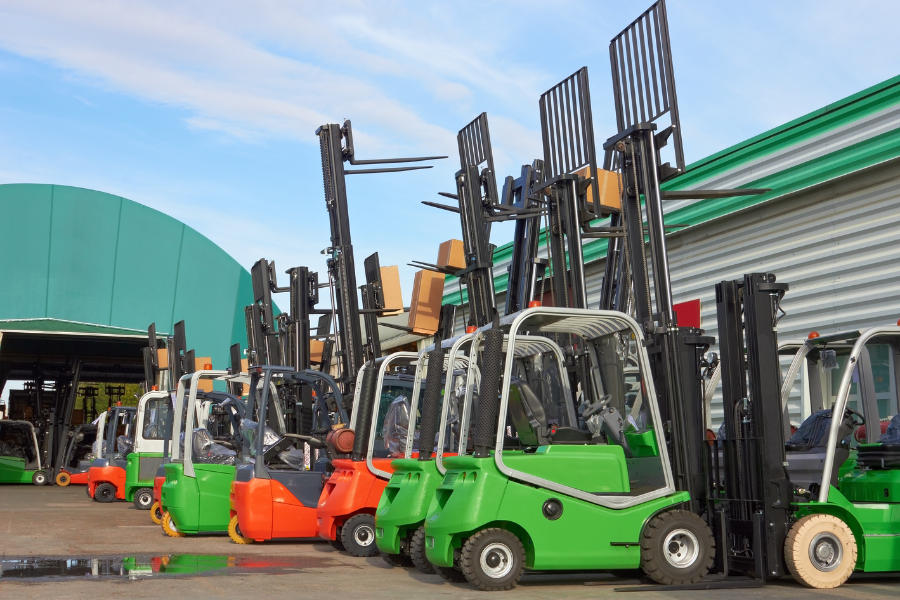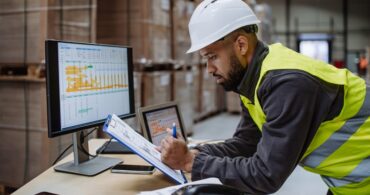Indoor and outdoor. Rough terrain and smooth. If an industry needs a forklift, there’s a model to fit the demand—and the type of engine used to power that industrial truck (and the forklift fuel it needs) is largely determined by where and how it is used.
As a provider of best-in-class motive power solutions, Texas Motive Solutions admits we’re partial to electric-powered industrial trucks. However, some jobs call for a differently powered machine. Let’s review the various forklift fuel types to discover how they impact a machine’s efficiency and effectiveness.
When it comes to forklift fuel, there are three broad categories: electric, internal combustion and dual fuel engines. However, inside those, there are several subcategories, such as electric forklifts using lead-acid batteries, lithium-ion batteries or hydrogen, and internal combustion engines using gasoline, diesel or liquefied petroleum gas (LPG).
Electric forklifts
Electric forklifts are powered by large, industrial batteries. Some can operate outdoors but most are designed for indoor work. A few benefits of electric forklifts include reduced emissions, less maintenance and a quieter operation. The most common are lead-acid and lithium-ion battery forklifts. However, batteries are continually being innovated, and new developments provide intriguing options.
A forklift’s battery size and capacity determine how long it can operate and, to some extent, how much it can lift. Lead-acid batteries, for example, are available in various capacities, typically ranging from 24 to 80 volts.
Lead-acid batteries
Lead-acid batteries have been around for nearly 200 years. Until recently, they were the undisputed standard for electric forklifts and remain the choice for many industries and applications. Lead-acid batteries are reliable and cost-effective. However, they require regular maintenance, such as watering and equalizing, to maintain performance and sustain lifespan.
When a lead-acid battery nears a 20% charge, it’s known as the “red zone.” You do not want a lead acid battery to hit the red zone, much less run down to a 0% charge. That can damage the battery and dramatically shorten its life. Charging the battery when the charge hits between 20% and 30% provides the ideal balance of battery life, performance and downtime.
The charging process for a lead-acid battery takes several hours. Then the batteries need to cool because charging generates a lot of heat. Using the battery while it is still hot can damage it. To get the most out of a lead-acid battery, it is recommended to follow the “8-8-8 Rule,” also known as conventional charging:
- 8 hours in operation.
- 8 hours on the charger.
- 8 hours to cool down.
Despite any charging challenges, the upfront costs of lead-acid batteries are significantly less than most other forklift batteries, which is one reason they remain popular and widely used.
Lithium-ion batteries
If you are reading this on a cell phone or laptop, you’re currently inches away from a lithium-ion battery. These batteries have been used commercially since the 1990s but have only been available for forklifts for over a decade. However, they have made a big impact in that relatively small amount of time.
One of the most significant advantages of lithium-ion batteries is they can be charged in a fraction of the time it takes a lead-acid battery. Most high-quality lithium-ion batteries can go from 0% to 100% charged in about an hour, and no cooldown period is necessary. Additionally, they can take advantage of “opportunity charging,” which means the battery can be charged when convenient and does not require a full charge.
The primary drawback of lithium-ion forklifts is their higher initial cost compared to lead-acid batteries. However, their total cost of ownership is often the same or lower due to reduced maintenance, longer battery life and energy savings.
Thin plate pure lead batteries
A thin plate pure lead battery (TPPL) is an evolution of the lead-acid battery. It utilizes slimmer electrodes and a higher purity lead, which helps make them more efficient and last longer. TPPLs are also a “low-maintenance battery: because they do not need to be watered or equalized.
Another advantage of TPPLs is their ability to opportunity charge. Because of their composition, TPPLs can charge to 70% capacity in about an hour. They also cost roughly 30% to 40% less than a lithium-ion battery. However, they do have a shorter lifespan than a lithium-ion battery. So, depending on usage, the lifetime cost of a single lithium-ion battery may equal those of a few TPPL batteries over the same period.
Hydrogen powered forklift
Hydrogen powered forklifts are one of the newest technologies in the material handling industry. These forklifts are powered by hydrogen fuel cells, which generate electricity by combining hydrogen with oxygen. The only byproduct is water vapor, which makes hydrogen a zero-emission, environmentally friendly fuel source.
The power source for a hydrogen powered forklift is known as a hydrogen fuel cell. While there are a few variations, the main forklift fuel cell type is known as proton exchange membrane (PEM). PEM fuel cells are compact and lightweight. Hydrogen fuel cells do not hold a charge, like a battery. Instead, the forklift is fueled with hydrogen (putting hydrogen in a forklift is like filling a car’s gas tank). The hydrogen is then sent to the fuel cell where it is converted into electricity.
Currently, there is not an extensive infrastructure of hydrogen refueling stations. This is why most hydrogen-powered vehicles are industrial ones that travel predictable routes and distances, such as forklifts that never journey far from their home base and passenger buses that follow the same route daily.
Internal combustion engine forklifts
Internal combustion (ICE) forklifts are powered by an engine that burns fuel. Due to the exhaust they emit, these machines are commonly used outdoors or in well-ventilated indoor areas. The primary fuel types used in ICE forklifts are gasoline, diesel and liquid propane.
Gasoline-powered forklifts
Anyone who has refueled a passenger car is familiar with the power source of a gasoline-powered forklift. A gasoline forklift tends to have a low initial cost and is relatively easy to maintain. It also provides a good balance between power and speed.
However, the operational costs of a gasoline forklift can be higher than electric or diesel and are very dependent on the fluctuating price of forklift gas. Gasoline forklifts also produce emissions, including carbon monoxide and nitrogen oxides, which can be harmful to the environment and pose a health risk to workers, especially in poorly ventilated areas.
Diesel-powered forklifts
If you have ever seen a forklift at a construction site, agricultural area or oil field and thought, “Wow, that’s a ginormous forklift,” it was likely powered by diesel. Diesel-powered forklifts are generally designed for heavy loads and rugged terrain—sometimes extremely heavy loads and very rugged terrain, like the giant beasts we just mentioned. They also typically have larger fuel tanks than gasoline-powered forklifts so they can operate for long periods without refueling.
Because of the wear and tear of the environment and the numerous moving parts necessary to handle heavy loads, diesel-powered forklifts have a shorter lifespan than most other trucks. In addition, diesel engines emit higher levels of nitrogen oxides and particulate matter than their gasoline-powered counterparts.
Whether diesel or gasoline, forklift tank sizes vary depending on the fuel type and intended application. The capacity of diesel and gasoline fuel for forklift tanks typically ranges from 10 to 30 gallons, depending on the model and manufacturer.
Liquefied petroleum gas forklifts
Liquefied petroleum gas (LPG) forklifts are also known as propane forklifts. An LPG forklift does not have an internal gas tank. Instead, the propane is stored in external tanks that are swapped when the truck needs refueling. Propane tanks for LPG forklifts are available in various sizes, with the most common being 8-gallon (33-pound) cylinders.
The cost of propane is relatively stable and often cheaper than gasoline or diesel. Additionally, LPG forklifts produce less carbon monoxide and other pollutants than both diesel- and gasoline-powered forklifts. This means LPG forklifts are often used indoors, although the area still needs appropriate ventilation.
Dual fuel forklifts
The rhythmically named dual fuel forklift is a machine that can operate on two different fuel sources. The most common type of dual fuel forklift utilizes gasoline and propane.
The main advantage of a dual fuel forklift is that it can operate outdoors using gasoline and switch to propane when it moves indoors. Operators can also decide to use one fuel source over the other based on availability and cost.
Your choice of forklift—and the various forklift fuel types—is directly impacted by your operational needs and work environment. If your organization relies on electric forklifts, we can help ensure that you’re using the best batteries for your needs with our complimentary forklift fleet performance analysis.
The Texas Motive Solutions non-invasive Power Study will discover:
- The power requirements your operation truly needs.
- How to improve operational efficiencies for optimal battery utilization.
- What type of forklift batteries and chargers would work best in your application.
- How to best optimize the performance of your forklift fleet to prolong battery life and ensure warranty coverage.
So, give us a call to supercharge your forklift fleet. Call (888) 316-2459 or fill out this form to learn about our services and discover everything we can do for you.



